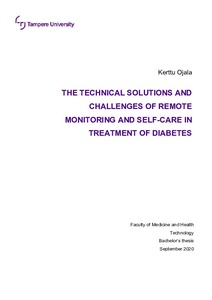The Technical Solutions and Challenges of Remote Monitoring and Self-care in Treatment of Diabetes
Ojala, Kerttu (2020)
Ojala, Kerttu
2020
Bioteknologian ja biolääketieteen tekniikan kandidaattiohjelma - Bachelor's Programme in Biotechnology and Biomedical Engineering
Lääketieteen ja terveysteknologian tiedekunta - Faculty of Medicine and Health Technology
This publication is copyrighted. You may download, display and print it for Your own personal use. Commercial use is prohibited.
Hyväksymispäivämäärä
2020-09-28
Julkaisun pysyvä osoite on
https://urn.fi/URN:NBN:fi:tuni-202009257127
https://urn.fi/URN:NBN:fi:tuni-202009257127
Tiivistelmä
Diabetes is a group of chronic diseases affecting millions of people worldwide. The costs of diabetes for the public economy are vast, and the life quality of diabetics could often bear improving, so new therapies are needed. In this literature review, telehealth solutions for the treatment of diabetes are researched. The goal of this work is to summarise the current state of telehealth diabetes treatment, research rising trends and to figure out the greatest challenges to be solved in the future.
First, the current treatment of diabetes and currently available telehealth solutions are presented. It was found out that despite the advances in the field made in recent years, a large part of the treatment of diabetes still relies on old-fashioned methods. Instead of insulin pumps and continuous glucose measurement devices, finger-prick tests for blood glucose monitoring and manual insulin injections are often still in use. The data transfer from self-care measurements to healthcare providers is often still dependent on manually transferring the data from a measurement device to computer where it can be then sent to a healthcare provider. The second part of the work focuses on the future of telehealth. There the greatest new developments are focused on better artificial pancreases and interoperable devices.
This review shows that there is a vast need for better telehealth solutions in the treatment of diabetes. Considering that the costs of just diabetic foot ulcers can be as high as 250 million euros per year in Finland alone, any savings in the field are bound to be significant to the public economy. The most important trend in telehealth currently is the increasing interoperability. As of now there is much to improve there, as strict regulation keeps companies from developing interoperable devices.
First, the current treatment of diabetes and currently available telehealth solutions are presented. It was found out that despite the advances in the field made in recent years, a large part of the treatment of diabetes still relies on old-fashioned methods. Instead of insulin pumps and continuous glucose measurement devices, finger-prick tests for blood glucose monitoring and manual insulin injections are often still in use. The data transfer from self-care measurements to healthcare providers is often still dependent on manually transferring the data from a measurement device to computer where it can be then sent to a healthcare provider. The second part of the work focuses on the future of telehealth. There the greatest new developments are focused on better artificial pancreases and interoperable devices.
This review shows that there is a vast need for better telehealth solutions in the treatment of diabetes. Considering that the costs of just diabetic foot ulcers can be as high as 250 million euros per year in Finland alone, any savings in the field are bound to be significant to the public economy. The most important trend in telehealth currently is the increasing interoperability. As of now there is much to improve there, as strict regulation keeps companies from developing interoperable devices.
Kokoelmat
- Kandidaatintutkielmat [7051]
